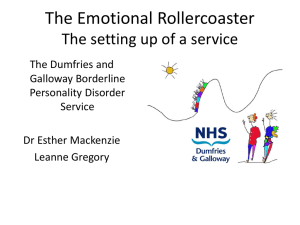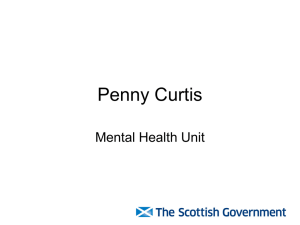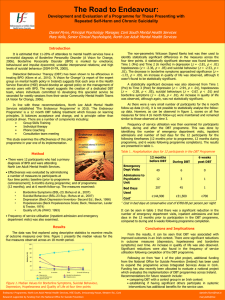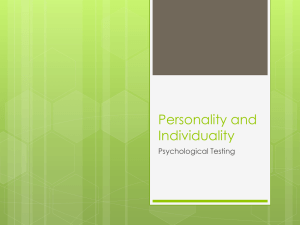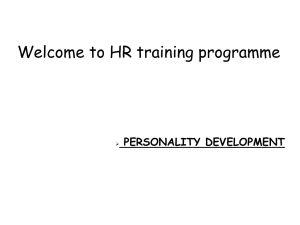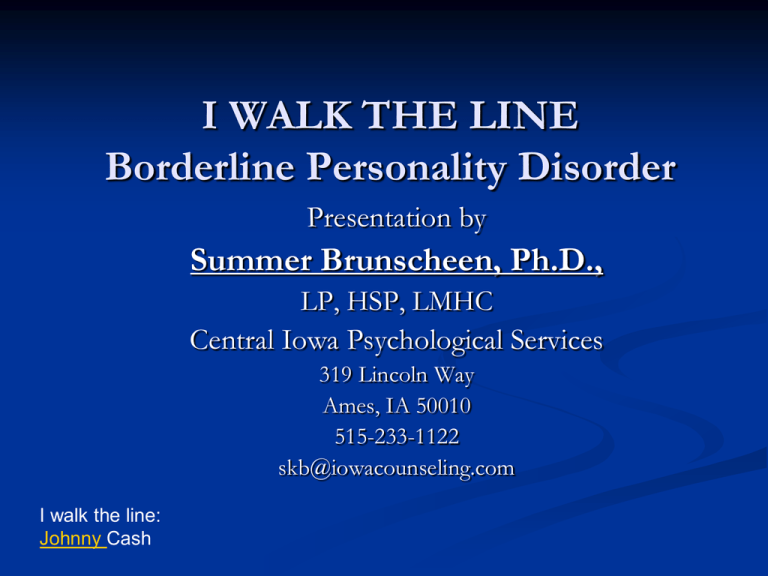
I WALK THE LINE
Borderline Personality Disorder
Presentation by
Summer Brunscheen, Ph.D.,
LP, HSP, LMHC
Central Iowa Psychological Services
319 Lincoln Way
Ames, IA 50010
515-233-1122
skb@iowacounseling.com
I walk the line:
Johnny Cash
Personality Disorders
PD’s enduring, pattern of inner experience and
behavior that deviates markedly from the
expectation’s of an individual’s culture,
Pervasive and inflexible
Onset in adolescence or early adulthood
PD patterns can be dx as young as age 5! (chaotic,
disorganized, bizarre, annihilation anxiety)
Stable over time, leads to distress or impairment
(Axis II “is” vs. Axis I “acts”)
Personality Disorders
Cluster B
Antisocial, Borderline, Histrionic, Narcissistic
(dramatic, emotional, erratic)
BPD affects:
2% of the general population
10% of an outpatient population
20% of an inpatient population,
74% of people diagnosed with BPD are female
Borderline Personality Disorder
BPD is often comorbid with ADHD, addictive
DO’s, and mood disorders
People with BPD are often poly-substance
abusers/self-medicating (avg 4.5 medications)
BPD per DSM-IV-TR (4 of 9)
Frantic efforts to avoid real or imagined
abandonment
Unstable, intense interpersonal relationships,
alternating between love and hate
Identity disturbance, unstable sense of self
BPD per DSM-IV-TR (4 of 9)
Impulsiveness in at least 2 areas that are
potentially self-damaging
spending,
sex,
substance use,
shoplifting,
reckless driving,
binge eating,
cutting
BPD per DSM-IV-TR (4 of 9)
Recurrent suicidal behavior
least likely to attempt when emotionally upset
8-10% suicide rate
Higher among those with SA
400 times the rate of general population
800 times the rate found in women 15-34
5-7 DSM characteristics = 7% suicide rate, 8 = 36%
suicide rate so check, document, and increase
interventions
BPD per DSM-IV-TR (4 of 9)
Affective instability (rarely last more than a few
hours, even more rarely more than a few days)
Chronic feelings of emptiness
Inappropriate, intense anger or lack of control
of anger, frequent displays of temper, constant
anger, recurrent physical fights
Transient stress-related paranoid ideation, severe
dissociative symptoms
Additional Characteristics
Disturbance in Self concept
Low Social Functioning/Unstable interpersonal
relationships
Negative affect/Labile affect
Dichotomous thinking
Additional Characteristics
Cognitive Disturbances
Unrelenting crises
Active passivity
Expressively Spasmodic
Additional Characteristics
Splitting
Self-Perpetuating Intrapsychic and Interpersonal
Processes
Counter Separation Maneuvers
Impulsive behaviors
Additional Characteristics
Sleep Disorders
Intimacy Terror
Catastrophic Thinking
Manipulative
Functional Failures
Differential Diagnosis
GET A REALLY COMPLETE ASSESSMENT
(including past treatment history)
Mood Disorders
BPD: Bipolar = QUICK mood changes, when
depressed is still impulsive, bipolar shifts are
neurological, BPD shifts are environmental (can see
what is triggering the mood shifts)
BPD: Depressive Suicidality = BPD motivated by
wish to gain sympathetic and binding response,
depressive motivated by despair and hopelessness
Differential Diagnosis
PTSD
Eating Disorders
Substance Abuse
From other PD’s
Tools for Assessment
Clinical interview:
historical patterns,
relationship patterns,
suicide attempts/self harm,
psychotic symptoms,
abuse history
Tools for assessment
Self-Report (Interview) Instruments:
Diagnostic Interview for Borderline Personality
Disorders-Revised,
Structured Clinical Interview for DSM-III-R
Personality Disorders,
PAI,
Borderline Personality Inventory,
Objective Behavioral Index
Assessment
Self Harm Inventory
Beck Scale for Suicidal Ideation
Suicide Probability Scale
MMPI-2
Rorschach
MCMI-II
Suicide Assessment
Previous suicidal attempts, lethal in nature
Specificity
Level of commitment
Availability of instruments
Level of impulsivity
Substance use
Social support availability
Self Harm Behaviors:
Attempts to “kill the pain”
Cutting: e.g. arms,
legs, stomach (80%)
Bruising (24%)
Burning (20%)
Head banging (15%)
Biting (7%)
Spending
Gambling
Substance Abuse
Promiscuity
Shoplifting
Reckless driving
Binge eating
Self harm behaviors
Gestures, threats, attempts, parasuicidal acts,
self-mutilation
As a way to communicate distress
90% show self-destructive behavior in the broad
sense
75% have at least 1 self-damaging act,
75% of acts occur b/n 18-45 years old
Self harm behaviors
We have three pain systems
Sharp
Hot/cold
Blunt
Can find out what the “just right” sensation is
and then do cognitive construction of WHY do
it
Self harm behaviors
Presence of self-injurious behaviors doubles the
likelihood of suicide
Suicidal behavior NOT necessarily related to
comorbid depression
Self harm acts often start as self-punitive
measures or ways to control affect then take on
increasing awareness and purpose of controlling
others
Research into the Cause of BPD
Psychoanalytic/Psychological/Developmental
Models
Trauma (Abuse) Model
Interpersonal/family psychological models
Genetic/biological models
Therapeutic
Approaches
Management context
Interventions done TO the client
Competency desired (not designed to create self
internal change)
Reduce chaos, avoid worsening, manage crises, try to
correct distorted relations with helping systems
Use when history of: failed tx, worsening in tx, abusing
the system, no motivation for tx
Use when the individual is not your psychotherapy
client
Therapeutic Approaches
Dialectical Behavior Therapy
Medications:
MAOI’s, SSRI’s, TCA’s, Neuroleptics, Lithium
Bicarbonate, Anticonvulsants, Opiate Antagonists,
Benzodiazepines
Psychodynamic Approach
Interpersonal Psychotherapy
Cognitive Psychotherapy
Therapeutic approaches
Psychoanalytic Approach
Cognitive Analytic Therapy
Relapse Prevention
Group Psychotherapy
Psycho-Educational Therapy
Family Therapy
Dialectical Behavior Therapy
developed by
Marsha M.
Linehan
DBT
faculty.washington.edu/linehan
Developed in the 1970’s by Marsha Linehan and
colleagues
Originally designed to treat suicidal behaviors
The only currently Empirically Validated
Treatment for BPD
Long term therapy not short term: best if in
both individual and group DBT therapy
Goals of Skills Training in DBT
Behaviors to Increase (Skills)
Mindfulness
Distress tolerance
Emotion Regulation
Interpersonal Effectiveness
Walking the Middle Path/Finding the Balance
Goals of Skills Training in DBT
Behaviors to Decrease (Problems)
Confusion about yourself
Impulsivity
Emotional Instability
Interpersonal Problems
Adolescent & Family Dilemmas
DBT Assumptions
You are doing the best you can.
You want to improve.
You need to do better, try harder, and be more
motivated to change.
DBT Assumptions
You may not have caused all of your own
problems but you need to solve them anyway.
The lives of suicidal & depressed adolescents are
painful as they are currently being lived.
It will generally be more effective for you to
learn new behaviors in all the important
situations in your life.
DBT Assumptions
There is no absolute truth.
It will generally be more effective if you and
your family would take things in a well meaning
way rather than assuming the worst.
You cannot fail in DBT.
DBT Skills
Dialectics
Finding the middle path
Validation
Dialectics
Acceptance
Acceptance
AND
Change =
Middle Path
Change
Dialectics:
Finding the Middle Path- Balance
Holding on too
tight
Forcing
independence
GIVING YOURSELF/YOUR ADOLESCENT GUIDANCE, SUPPORT,
AND RULES TO HELP YOURSELF/YOUR ADOLESCENT FIGURE
OUT HOW TO BE RESPONSIBLE WITH YOUR/THEIR INCREASED
FREEDOM
And at the same time
SLOWLY GIVING YOURSELF/YOUR ADOLESCENT GREATER
AMOUNTS OF FREEDOM AND INDEPENDENCE WHILE ALLOWING
AN APPROPRIATE AMOUNT OF RELIANCE ON OTHERS
Learning to think dialectically: Practice
ID the dialectic statement:
a) No one ever listens to me.
b) People are always available to me and listen to whatever I feel.
c) Sometimes I do not feel listened to and it is very frustrating.
Learning to think dialectically: Practice
ID the dialectic statement:
a) I may not have caused all of my problems, but I need to solve
them anyway.
b) It is not my fault that I have these problems so I am not going
to even try.
c) All of my problems are my own fault.
Validation
What is validation?
Validation communicates to another person that his or
her responses (feelings, thoughts, actions) make sense
and are understandable to you in a particular situation.
Acknowledgement (observing & describing
nonjudgmentally) “I can see that you are really upset now”
Acceptance: “I know you are upset.” “I am upset”.
Validation
REMEMBER:
VALIDATING IS NOT NECESSARILY AGREEING
VALIDATING DOES NOT MEAN THAT YOU LIKE WHAT THE
OTHER PERSON IS DOING, SAYING, OR FEELING
Validation/Invalidation Levels and Types
Validation
Basic attention, listening,
ordinary non-verbals
Reflecting or acknowledging
the other’s disclosures; what
she/he is
thinking/feeling/wanting; or
functionally responding to
her/him by answering or
problem-solving
Articulating/offering ideas
about what the other might
want/feel/think, etc., in an
empathic way; helping the
other clarify; asking questions
to help clarify
Invalidation
Not paying attention,
distractible, changes, changes
subject, anxious to leave or to
end the conversation
Not participating actively,
missing ordinary
conversational validation
opportunities, not providing
evidence of tracking the other
person; functionally
unresponsive
Telling the other person what
she/he DOES feel/think/
want, etc. even when the other
provides contradictory
statements; or telling what
she/he SHOULD feel/etc.
Validation/Invalidation Levels and Types
Validation
Recontextualizing the other’s
behavior; putting more positive
spin on it; acceptance because of
history; reducing the negative
valence.
Normalizing other’s behavior given
present circumstances
Empathy, acceptance of the person
in general; acting from balance
about the relationship; not treating
the other as fragile or incompetent,
but rather as equal & competent.
Reciprocal vulnerability/ selfdisclosure in context of the other’s
vulnerability, & the focus stays on
the other person
Invalidation
Agreeing with other person’s selfinvalidation when behavior makes
sense in terms of history & could
be spun differently; increasing it
negative valence
Criticizing other’s behavior when it
is reasonable or normative in
present circumstances
Patronizing, condescending, &/or
contemptuous behavior toward the
other; treating the other as not
equal or incompetent; character
assaults/ over-generalizing
negatives.
Leaving the other person hanging
out to dry; not responding to
his/her vulnerable self-disclosures,
thereby assuming a more powerful
position.
Mindfulness Handout 1
Taking Hold of Your Mind:
States of Mind
Reasonabl
e Mind
Wise
Mind
Emotional
Mind
DBT Skills
Mindfulness
Emotional Mind
Analytical Mind
Wise Mind
HOW skills
WHAT skills
DBT skills
Distress Tolerance
Crisis Survival
ACCEPTS
Self-Soothing
IMPROVE the moment
Thinking of Pro’s and Con’s (ST and LT)
Remember…
ACCEPTANCE OF REALITY IS
NOT EQUIVALENT TO THE
APPROVAL OF REALITY
Coping with Urges & Feelings:
Why Bother
Coping with emotional pain is important for
three main reasons:
Pain is a part of life & can’t always be avoided.
If you can’t deal with your pain, you may act
impulsively.
When you act impulsively, you may end up hurting
yourself or not getting what you want.
Radical Acceptance
Suffering is not accepting pain
Acceptance is:
Letting go of fighting reality
Turning suffering you can’t cope with into pain you
can cope with
Acceptance is NOT approval
Acceptance Myths
Three myths about acceptance:
If you refuse to accept something, it will magically
change.
If you accept your painful situation, you will become
soft & just give up (or give in)
If you accept your painful situation, you are
accepting a life of pain
Willingness
Cultivate a willing response to each situation
Willingness is doing just what is needed in each
situation. It is focusing on effectiveness.
Willingness is listening very carefully to your wise
mind, acting from your inner self
(Over) Willfulness
Replace willfulness with willingness
Willfulness is sitting on your hands when action is
needed, refusing to make changes that are needed.
Willfulness is giving up.
Willfulness is the opposite of “doing what works”,
or being effective.
Willfulness is trying to fix every situation.
Willfulness is refusing to tolerate the moment.
DBT Skills
Emotion Regulation
Reducing vulnerability: STRONG skills
Increase positive emotions
Opposite Action
Short List of Emotions
Love
Hate
Fear
Joy
Shame
Guilt
Anxiety
Loneliness
Anger
Frustration
Sadness
Shyness
Boredom
Surprise
Numbness
Confusion
Curiosity
Suspiciousness
Rage
Interest
Depression
Worry
Hopelessness
Irritability
Panic
Jealousy
Optimism
Embarrassment
Pain
Sympathy
Research suggests all emotions can be categorized by the 7 basic
emotions
The Interaction of Emotions With
Thoughts & Behaviors
Thoughts about the event
Emotion
s about
event
Event
Body Reactions
Actions
Taking Charge of Your Emotions:
Why Bother?
Taking charge of your emotions is important
because:
Suicidal & depressed adolescents often have intense
emotions, such as anger, frustration, depression or
anxiety.
Difficulties controlling these emotions often lead to
suicidal & other self-destructive behaviors.
Suicidal & other self-destructive actions are often
behavioral solutions to intensely painful emotions.
Pleasant Activities List
Make a list of fun, SAFE, things you can do to
DISTRACT, SELF-SOOTHE, increase positive
emotions, lower negative moods, can be
opposite actions
Opposite Action
Step 1
Figure out what emotion you are experiencing. You
may need to do step 2 first if this is difficult.
Step 2
Determine the action urge, in other words, what you
feel like doing.
Opposite Action
Action Urge for the 7 Basic Emotions
EMOTION
ACTION URGE
Interest
-----------------------
Explore
Sadness
-----------------------
Withdraw
Anger
-----------------------
Attack
Shame
-----------------------
Hide
Fear
-----------------------
Run/Avoid
Love
-----------------------
Approach
Joy
-----------------------
Being Active
Opposite Action
Step 3
Ask yourself, “Do I want to reduce this emotion?”
Set 4
It is very difficult to actually do Opposite Action if you are not
genuinely interested in changing the emotion. In some situations a
person might have a negative emotion that he or she would prefer
not having, but does not want to change, as in grief at the loss of a
loved one.
Figure out the emotion’s opposite action.
Step 5
This involves actually doing Opposite Action all the way.
Opposite Action
Emotion
Action
Opposite Action
Afraid/Fear
Run/Avoid
Approach
Anger
Attack/Judgmental
Thoughts
Gently Avoid
Sad
Withdraw
Get Active
Shame
Hide
Approach
DBT skills
Interpersonal Effectiveness
Keeping a good relationship
Getting someone to do what you want
GIVE skills
DEAR MAN skills
Keeping your self-respect
FAST skills
Ask for Something?
Say No to Something? (Cont)
In order to decide whether to ask for or say no to
something, the things one needs to consider
include:
Priorities
Capability
Timeliness
Authority
Rights
Relationship
What Stops You From Achieving Your Goal?
Lack of skill
Worry thoughts
You actually don’t know what to say or how to act.
You have the skill, but your worry thoughts interfere
with doing or saying what you want.
Emotions
Can’t Decide
Environment
Questions? Comments?
skb@iowacounseling.com
515-233-1122
Thank you for coming!
References
American Psychiatric Association. (2000). Diagnostic and
Statistical Manual of Mental Disorders, Fourth Edition, Text
Revision, Washington D.C.: American Psychiatric
Association.
Barnes, R. (1985). Women and self-injury. International
Journal of Women's Studies, 8(5), 465-475.
Batty, D. (1998). Coping by cutting. Nursing Standards,
12(29), 25-6.
Beck, A.T. & Freeman, A. (1990). Cognitive therapy of
personality disorders. New York: Guilford.
References
Bockian, N.R., Villagran, N.E., & Porr, V. (2002). New
hope for people with borderline personality disorder: Your friendly,
authoritative guide to the latest in traditional and complementary
solutions. New York: Three Rivers Press.
Brodsky, B. S., Cliotre, M, & Dulit, R. A. (1995).
Relationship of dissociation to self-mutilation and childhood abuse
in borderline personality disorder. American Journal of
Psychiatry, 152, 1788-92.
Cauwels, J. (1992). Imbroglio: Rising to the challenges of
borderline personality. New York: W.W. Norton.
References
Clarkin, I.F., Yeomans, F.E., & Kernberg, O.F. (1999).
Psychotherapy for borderline personality disorder. New York:
John Wiley.
Cowdry, R. W. & Gardner, D. L. (1988).
Pharmacotherapy of borderline personality disorder:
Alprazolam, carbamazepine, trifluoperazine, and
tranylcypromine. Archives of General Psychiatry, 45(2), 111119.
Crawford, M. J., Turnbull, G., & Wessely, S. (1998).
Deliberate self-harm assessment by accident and
emergency staff -- an intervention study. Journal of
Accident and Emergency Medicine, 15(1), 18-22.
References
Dawson, D. & MacMillan, H.L. (1993). Relationship
management of the borderline patient: From understanding to
treatment. New York: Brunner/Mazel.
Favazza, A. R. (1998). The coming of age of selfmutilation. Journal of Nervous and Mental Disease, 186(5),
259-68.
Favazza, A. R. (1996). Bodies under Siege: Self-Mutilation
and Body Modification in Culture and Psychiatry, 2nd ed.
Baltimore: The Johns Hopkins University Press.
Favazza, A. R. (1989). Why patients mutilate themselves.
Hospital and Community Psychiatry.
References
Favazza, A. R. & Rosenthal, R. J. (1993). Diagnostic issues
in self-mutilation. Hospital and Community Psychiatry.
44(2), 134-140.
Gabbard, G.O. & Wilkinson, S.M. (1994) Management of
countertransference with borderline patients. Washington, DC:
American Psychiatric Press.
Gunderson, J.G. (2001). Borderline personality disorder: A
clinical guide. Washington, DC: American Psychiatric
Press.
Gunderson, J.G. & Gabbard, G.O. (eds.) (2000).
Psychotherapy for personality disorders. Washington, DC:
American Psychiatric Press.
References
Haines, J. & Williams, C. L. (1997). Coping and problem
solving of self-mutilators. Journal of Clinical Psychology,
53(2), 177-186.
Haines, J., Williams, C. L., Brain, K. L., Wilson, G. V.
(1995). The psychophysiology of self-mutilation. Journal of
Abnormal Psychology, 104(3), 471-489.
Hawton, K., Arensman, E., Townsend, E., Bremner, S.,
Feldman, E., Goldney, R., Gunnell, D., Hazell, P., van
Heeringen, K., House, A., Owens, D., Safinosky, I., &
Traskman-Bendz, L. (1998). Deliberate self-harm: systematic
review of efficacy of psychosocial and pharmacological treatments
in preventing repetition. BMJ, 317(7156), 441-7.
References
Herman, J. L. (1992). Trauma and recovery. New York:
Basic Books.
Kernberg. O.F. (1975). Borderline conditions and pathological
narcissism. New York: Jason Aronson.
Kernberg, O. F. (1986). Severe personality disorders:
Psychotherapeutic strategies. New Haven: Yale University
Press.
Koenigsberg, H.W., Stone, M.H., Appelbaum, A.H.,
Yeomans, F.E., & Diamond, D. (2000). Borderline
patients: Extending the limits of treatability. New York: Basic
Books.
References
Kreisman, J.J. & Straus, H. (1989). I hate you, don’t leave
me: Understanding the borderline personality disorder. New
York: Avon Press.
Landecker, H. (1992). The role of childhood sexual trauma in
the etiology of borderline personality disorder: Considerations for
diagnosis and treatment. Psychotherapy, 29, 23442.
Lester G. W. (2003). Personality disorders in social work and
healthcare. Nashville: Cross Country University and
Houston: Ashcroft Press.
Lester, G.W. (2004). Borderline personality disorder:
Treatment and management that works. Nashville, TN:
Greg Lester & Cross Country University.
References
Linehan, M. M. (1993a). Cognitive-behavioral treatment of
borderline personality disorder. New York: The Guilford
Press.
Linehan, M. M. (1993b). Skills training manual for treating
borderline personality disorder. New York: The Guilford
Press.
Linehan, M. M., Armstrong, H., Suarez, A. Allmon, D.
& Heard, H. (1991). Cognitive-behavioral treatment of
chronically parasuicidal borderline patients. Archives of
General Psychiatry, 48, 1060-1064.
Linehan, M. M., Oldham, J. & Silk, K. (1995). Dx:
Personality disorder-- now what? Patient Care, 29(11), 75-83.
References
Linehan, M. M., Tutek, D., Heard, H. & Armstrong, H.
(1992). Interpersonal outcome of cognitive behavioral treatment
for chronically suicidal borderline patients. American Journal of
Psychiatry, 151(12), 1771-1775.
Magnavita, J.J. (1997). Restructuring personality disorders: A
short-term dynamic approach. New York: Guilford.
Marziali, E., &Munroe-Blum, H. (1994). Interpersonal
group therapy for borderline personality disorder. New York:
Basic Books.
References
Mason, P.T. & Kreger, R. (1998). Stop walking on
eggshells: Taking your life back when someone you care
about has borderline personality disorder. Oakland,
CA: New Harbinger Publications, Inc.
Masterson, J.F. (1981). The narcissistic and
borderline disorders: An integrated developmental
approach. New York: Brunner/Mazel.
Masterson, J.F. (2000). The personality disorders:
Theory, diagnosis, treatment. Phoenix: Zieg, Tucker.
References
Miller, D. (1994). Women who hurt themselves: A book of
hope and understanding. New York: Basic Books.
Millon, T. & Davis, R. (2000). Personality disorders in
modern life. New York: John Wiley.
Paris, J. (2003). Personality disorders over time: Precursors,
course, and outcome. Washington, DC: American
Psychiatric Press.
Preston, J.D. (1997). Shorter term treatments for borderline
personality disorder. Oakland, CA: New Harbinger
Publications, Inc.
RecoverYourLife.com
References
Reiland, R. (2002). I’m not supposed to be here: My recovery
from borderline personality disorder. Milwaukee, WI:
Eggshells Press.
Roberts, A. R., ed. (1975). Self-destructive behavior.
Springfield, IL: Thomas.
Santoro, J. (2001) The angry heart: Overcoming borderline and
addictive disorders: An interactive self-help guide. New York:
MJF Books.
Silk, K.R. (ed.) (1998). Biology of personality disorders.
Washington, DC: American Psychiatric Press.
References
Simeon, D., Stanley, B., Frances, A., Mann, J. J.,
Winchel, R., & Stanley, M. (1992). Self-mutilation in
personality disorders: psychological and biological correlates.
American Journal of Psychiatry, 149(2), 221-226.
Simpson, E. B., Pistorello, J., Begin, A., Costello, E.,
Levinson, J., Mulberry, S., Pearlstein, T., Rosen, K., &
Stevens, M. (1998). Use of dialectical behavior therapy in a
partial hospital program for women with borderline personality
disorder. Psychiatric Services, 49(5). 669-73.
References
Spradlin, S. (2003). Don’t let emotions run your life:
How dialectical behavior therapy can put you in control.
Oakland, CA: New Harbinger Publications, Inc.
St. John, D. (2000). Relationship management and
functional improvement in the care of the BPD patient.
Journal of the American Academy of Physicians'
Assistants, 13, 40-52.

